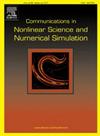Robust numerical framework for simulating 2D fractional time–space stochastic diffusion equation driven by spatio-temporal noise: L1-FFT hybrid approach
IF 3.4
2区 数学
Q1 MATHEMATICS, APPLIED
Communications in Nonlinear Science and Numerical Simulation
Pub Date : 2025-03-31
DOI:10.1016/j.cnsns.2025.108791
引用次数: 0
Abstract
This paper presents an in-depth analysis of numerical methods for solving two-dimensional fractional time–space stochastic diffusion equations, employing the Caputo fractional derivative and the fractional Laplacian. The study utilizes the L1-algorithm for temporal discretization, ensuring an accurate representation of fractional dynamics, while the Fast Fourier Transform is applied for spatial discretization to efficiently handle large-scale computational challenges. The spatio-temporal multiplicative Gaussian noise is modeled as the product of a Brownian sheet and a Brownian bridge, with the 2D Karhunen–Loève expansion implemented for noise generation. This approach is evaluated against Euler-type simulation technique, establishing a robust framework for stochastic simulations. Through comprehensive testing using two benchmark initial conditions — the sinc function and a single Gaussian distribution — the effectiveness of the proposed approach was validated in resolving two-dimensional fractional stochastic diffusion equations and simulating pollutant concentration dispersion patterns. These advanced methodologies enhance the understanding of fractional diffusion processes and offer practical tools for addressing complex problems in environmental modeling and related fields.
模拟时空噪声驱动的二维分数时空随机扩散方程的鲁棒数值框架:L1-FFT混合方法
本文深入分析了用卡普托分数阶导数和分数阶拉普拉斯算子求解二维分数阶时空随机扩散方程的数值方法。该研究利用l1算法进行时间离散化,确保分数动态的准确表示,而快速傅立叶变换应用于空间离散化,以有效地处理大规模的计算挑战。将时空乘性高斯噪声建模为布朗片和布朗桥的乘积,采用二维karhunen - lo展开进行噪声生成。该方法与欧拉型模拟技术进行了对比,建立了一个可靠的随机模拟框架。通过使用两个基准初始条件(sinc函数和单一高斯分布)的综合测试,验证了所提出方法在求解二维分数阶随机扩散方程和模拟污染物浓度扩散模式方面的有效性。这些先进的方法增强了对分数扩散过程的理解,并为解决环境建模和相关领域的复杂问题提供了实用工具。
本文章由计算机程序翻译,如有差异,请以英文原文为准。
求助全文
约1分钟内获得全文
求助全文
来源期刊

Communications in Nonlinear Science and Numerical Simulation
MATHEMATICS, APPLIED-MATHEMATICS, INTERDISCIPLINARY APPLICATIONS
CiteScore
6.80
自引率
7.70%
发文量
378
审稿时长
78 days
期刊介绍:
The journal publishes original research findings on experimental observation, mathematical modeling, theoretical analysis and numerical simulation, for more accurate description, better prediction or novel application, of nonlinear phenomena in science and engineering. It offers a venue for researchers to make rapid exchange of ideas and techniques in nonlinear science and complexity.
The submission of manuscripts with cross-disciplinary approaches in nonlinear science and complexity is particularly encouraged.
Topics of interest:
Nonlinear differential or delay equations, Lie group analysis and asymptotic methods, Discontinuous systems, Fractals, Fractional calculus and dynamics, Nonlinear effects in quantum mechanics, Nonlinear stochastic processes, Experimental nonlinear science, Time-series and signal analysis, Computational methods and simulations in nonlinear science and engineering, Control of dynamical systems, Synchronization, Lyapunov analysis, High-dimensional chaos and turbulence, Chaos in Hamiltonian systems, Integrable systems and solitons, Collective behavior in many-body systems, Biological physics and networks, Nonlinear mechanical systems, Complex systems and complexity.
No length limitation for contributions is set, but only concisely written manuscripts are published. Brief papers are published on the basis of Rapid Communications. Discussions of previously published papers are welcome.
 求助内容:
求助内容: 应助结果提醒方式:
应助结果提醒方式:


